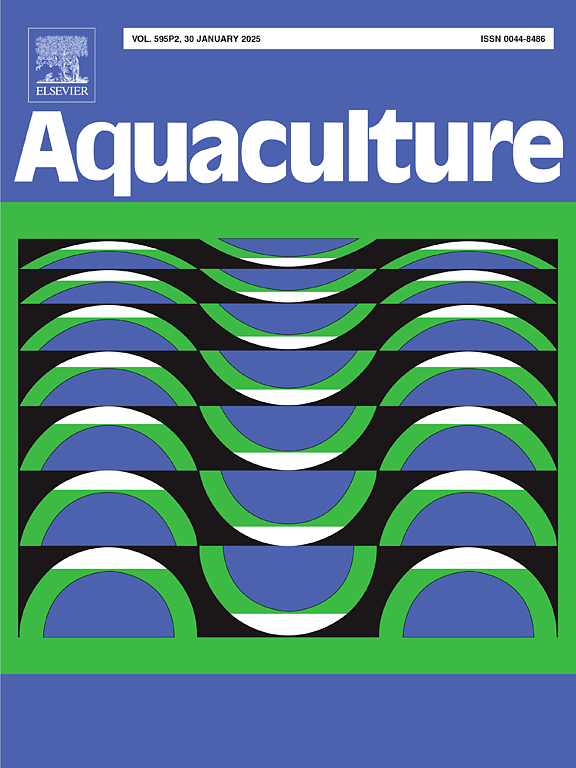Dietary bile acids reduced ferroptosis, improved the flesh quality and intestinal health of Pacific white shrimp (Litopenaeus vannamei) fed the high plant protein-based diets
IF 3.9
1区 农林科学
Q1 FISHERIES
引用次数: 0
Abstract
Bile acids (BAs) have been shown to improve the growth performance of shrimp and are essential for their lipid metabolism. This study examined the impacts of incorporating BAs into a diet rich in plant-based proteins on growth performance, flesh quality, intestinal health, and ferroptosis of Litopenaeus vannamei. A total of seven diets were formulated, featuring a 25 % fish meal diet as the positive control (PC) and a 12.5 % fish meal diet designated as the negative control (NC). The remaining five diets were produced by supplementing varying amounts of BAs at 50, 100, 200, 400, and 800 mg/kg in the NC, labeled as NC50 to NC800. In comparison with the PC group, no differences were observed in the final body weight (FBW) and weight gain rate (WGR) of the NC group (P > 0.05). The FBW and WGR of the shrimp were significantly increased when 400 mg/kg BAs were added to the NC group (P < 0.05). A comparison of shrimp from the PC and NC groups showed that the latter group had significantly higher crude lipid content (P < 0.05), which was further increased in shrimp fed the diets supplemented with more than 200 mg/kg BAs in the NC group (P < 0.05). Immunofluorescence analysis indicated that the protein expression of GPX4 was lower in the NC group than in the PC and NC400 groups (P < 0.05). Transmission electron microscopy analyses showed that the mitochondrial cristae disappeared, and the lipid peroxidation metabolite (MDA) content was significantly increased in the NC group compared to the PC group (P < 0.05). Moreover, high-plant protein-based feed significantly increased the expression of genes linked to ferroptosis, including acsl4, hoi, and fettrin (P < 0.05). However, the inclusion of BAs can significantly diminish those mentioned metrics (P < 0.05). Furthermore, the inclusion of BAs in high-plant protein diets not only decreased cooking loss but also enhanced the texture properties of shrimp muscle, including hardness, cohesiveness, resilience, and springiness (P < 0.05). The supplementation of BAs also led to an upregulation of genes related to muscle fiber growth, specifically tgf-β, tor, smych1, and smych2 (P < 0.05). Results from the Western blot and histological analyses revealed a significant upregulation of myofibrillar proteins including Akt, 4E-BP1, Raptor, and MyoD1, which also led to a marked increase in the diameter of muscle fibers (P < 0.05). Furthermore, electron microscopy revealed that incorporating BAs into high-plant protein diets led to a marked increase in both the width and height of the intestinal folds of shrimp, along with a growth in the density of microvilli (P < 0.05). In conclusion, the inclusion of BAs into diets rich in plant-based proteins can enhance the growth performance, flesh quality, resistance to ferroptosis, and improve the intestinal health of L. vannamei.

膳食胆汁酸可降低太平洋南美白对虾(Litopenaeus vannamei)的铁蛋白沉积,改善其肉质和肠道健康状况
本文章由计算机程序翻译,如有差异,请以英文原文为准。
求助全文
约1分钟内获得全文
求助全文
来源期刊

Aquaculture
农林科学-海洋与淡水生物学
CiteScore
8.60
自引率
17.80%
发文量
1246
审稿时长
56 days
期刊介绍:
Aquaculture is an international journal for the exploration, improvement and management of all freshwater and marine food resources. It publishes novel and innovative research of world-wide interest on farming of aquatic organisms, which includes finfish, mollusks, crustaceans and aquatic plants for human consumption. Research on ornamentals is not a focus of the Journal. Aquaculture only publishes papers with a clear relevance to improving aquaculture practices or a potential application.
 求助内容:
求助内容: 应助结果提醒方式:
应助结果提醒方式:


